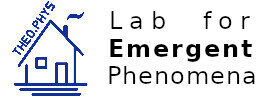PhD thesis – Susan Nachtrab
Susan Nachtrab
Percolation and Elasticity of Networks – From Cellular Structures to Fibre Bundles [Full text via OPUS]
finished 2011-12
supervised by Klaus Mecke and Gerd Schröder-Turk
Abstract
A material’s microstructure is a principal determinant of its effective physical properties. Structure-property relationships that provide a functional form for the dependence of a physical property (e.g. elasticity) on the microstucture’s morphology are essential for the physical understanding and also the practical application in material design. This work focuses on materials with spatial mesoscopic network structure. A new model with adjustable network topology is introduced and its percolation properties and effective elastic properties are examined.
In an initially four-coordinated network, ordered or disordered, each vertex is separated with probability p to form two two-coordinated vertices, yielding network geometries that change continuously from network structures to bundles of unbranched, interwoven fibres.
The percolation properties of this so-called vertex model are studied for a two-dimensional square lattice and a three-dimensional diamond network, revealing a percolation transition at p = 1 in both cases. The analysis of the pair-connectedness function and finite size scaling exhibits critical behaviour with critical exponents β = 0.32 ± 0.02,
ν = 1.29 ± 0.04 in two dimensions and β = 0.0021 ± 0.0004, ν = 0.54 ± 0.01 in three dimensions. The values of the exponents differ from those of conventional site and bond percolation, indicating that this vertex model belongs to a different universality class. In addition, in three dimensions the critical exponents do not obey the hyperscaling relations of bond percolation, but a heuristic new hyperscaling relation is found.
After inflating the network edges to circular cylinders of finite radius, the resulting structure is interpreted as solid material in network shape, henceforth called network solid. Changes of probability p strongly affect the mechanical properties of such network solids. This is demonstrated by calculating the effective linear-elastic bulk and shear moduli using a finite element method based on voxel representations of the structures. Separating a fraction of the network nodes leads to a strong decay of the effective moduli whose functional dependence can be approximated, for p < 0.5, by an exponential decay for both, fixed and periodic boundary conditions. This is verified for ordered (diamond and nbo) as well as for irregular (foam) initial structures. Compression experiments on laser-sintered models based on diamond network solids confirm these results. In case of periodic boundary conditions, a cross-over from an exponential to a power-law decay in (1 − p) close to the critical point at p = 1 is observed. From this, the elastic critical exponent fc can be estimated as fc = 3.0 ± 0.1, which also differs from the site and bond percolation exponent.
The morphological analysis of this work has several applications. For linear-elastic solids, it suggests that the network connectivity can be used as design parameter, for example for open-cell metal foams or bone scaffolds, as the elastic properties can be adjusted to a given value while keeping the pore space geometry and thus transport properties almost constant. The results of the percolation analysis are especially relevant for network models of biological or synthetic polymers with varying degree of cross-linking.
